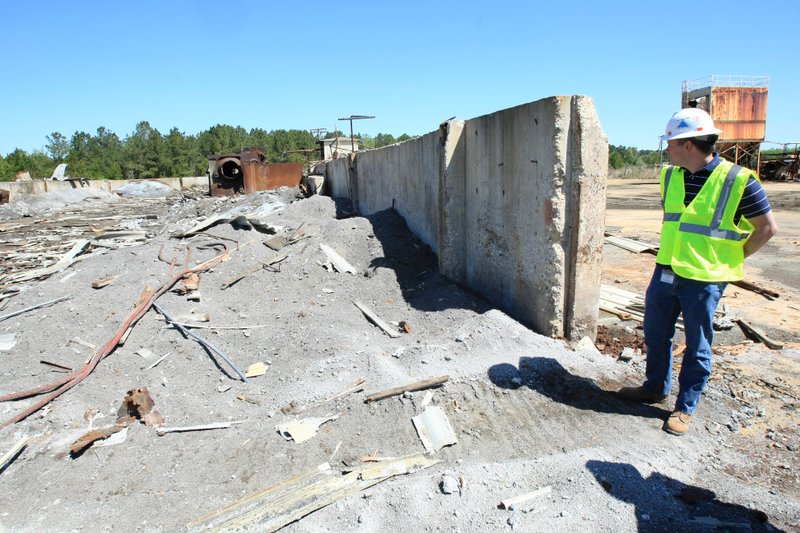LITTLE ROCK — Stamps Mayor Ian Ouei knows that his vision for the property just outside his town is a long way from the twisted metal and trash left by a defunct aluminum-recycling plant, but he can dream - especially now that the state has begun cleanup in earnest.
“A pipe dream would be to develop it so it could be a recreational area,” Ouei said. “We have lots and lots of kids that play baseball and softball, so a baseball diamond would be nice, plus some kind of riding arena for a rodeo.”
A $1 million contract to clean up Red River Aluminum in Stamps, awarded to Pollution Management, is one of two major cleanups under way by the Arkansas Department of Environmental Quality.
A $2.4 million contract to clean up the defunct R&P Electroplating site in Fayetteville was awarded to Pensacola, Fla.-based Southern Environmental Management and Specialties Inc. Work at the site is beginning this week, said Ryan Benefield, deputy director of the Department of Environmental Quality.
Both projects are being paid for from the state’s $12.7 million Remedial Action Trust Fund. The money is generated from fines for environmental infractions.
Work began at the Stamps site on March 29 and is expected to be complete by late June, said Tony Scott, the project manager.
Benefield was chief of the hazardous waste division when the department ordered an investigation of the Stamps site to determine what action would be needed. The site operated from 1985 to 1997 and went bankrupt in 1998.
Benefield said Thursday while touring the site that it was gratifying to see work finally under way.
“It’s great to see it get to this point,” Benefield said. “It will be even greater if I get to see it reused.”
Before cleanup begins, a lengthy administrative process had to be completed, including an in-depth investigation of hazards at each site and public hearings.
At the aluminum plant, a mountain of aluminum dross - a recycling byproduct that resembles charcoal ash - sits amid dilapidated buildings. The waste has a high chloride and salt content that accelerated the deterioration of the steel beams that once held the buildings up.
While walking last week past a building that fell down,Benefield easily snapped a flaky piece of steel from a beam using his thumb and forefinger.
“A lot of the things we deal with aren’t what we call acutely hazardous where it’s going to harm you to be in it for a small period of time,” Benefield said. “But maybe long-term exposure could cause harm to the sensitive populations like the young or elderly.”
An 8-acre landfill on the site will be reopened so the dross and corroded building materials can be deposited. After that, the landfill will be covered with clay sheeting, then soil so grass seeds can take hold.
The landfill will be fenced to prevent vehicles from tearing through the covering thus allowing water in to mix with the waste and possibly seep into the soil, but foot traffic would be allowed, Benefield said.
He noted that the current soil covering on the landfill began to erode, which allowed the waste to mix with rainwater, run off the landfill and kill vegetation. The site is about 120 acres, but the facility operated on 100 acres, a summary of the project shows.
“There was a large dead zone where the salt runoff occurred,” Benefield said, pointing to a now-grassy area between the landfill and a neighborhood about 100 yards away. “Having controlled the salt, the vegetation has returned. The last time I was here about a year ago, there were some horses grazing on the other side of that fence.”
Scott said some soil, contaminated with petroleum, will also be removed from the site.
“We’ll have to haul that to the appropriately certified landfill,” Scott said.
At R&P Electroplating, which operated from 1974 to 1997, the cleanup plan includes removing and filling in sumps - pits that collected water and chemicals - to minimize the potential for further groundwater degradation, controlling the migration of affected groundwater and long-term monitoring.
Some cleanup at the site has already taken place. In 1998, vandals caused “a release of an undetermined amount of various hazardous substances,” a department summary of the project shows. Emergency action was taken.
The cleanup of the 5.78-acre Fayetteville site is expected to take about four months, said Clyde Rhodes, chief of the department’s hazardous waste division. Both sites are now owned by the Arkansas Commissioner of State Lands.
Ouei visits the site outside Stamps often to chat with Scott about the progress of the cleanup. He said the site has potential.
“We have no real plans right now because the property is not ours, it belongs to the state,” Ouei said. “A recreation complex that could host tournaments would be a good draw for the town. Obviously we don’t have the money to do that all at once, but that’s what I’d like to see go in there.”
Arkansas, Pages 9 on 04/12/2010

